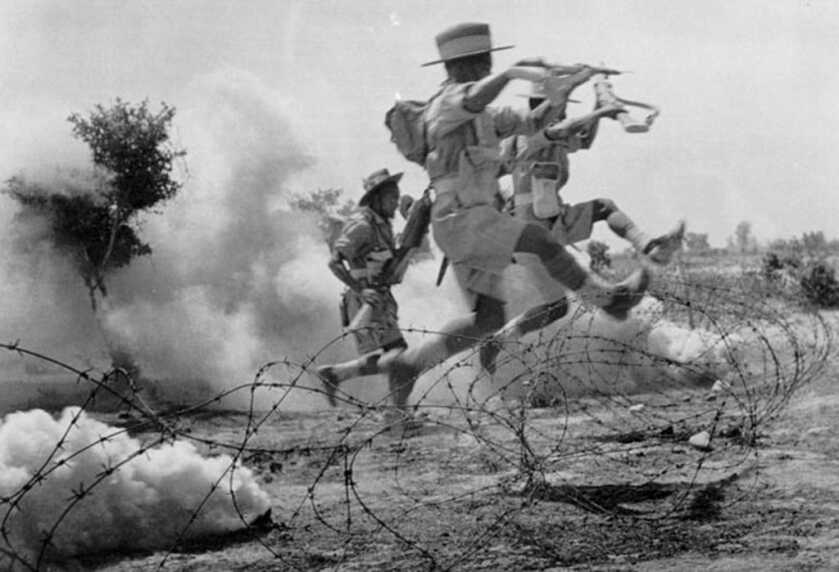 Lachhiman Gurung seemed an unremarkable sort. He stood all of four feet eleven inches tall when he left his village to buy cigarettes for his father and ended up enlisting as a Gurkha in the service of the British Empire on a whim. However, on May 12, 1945, deep in a Burmese jungle Lachhiman Gurung proved that sometimes some of the most remarkable stuff comes in compact packages.
Lachhiman Gurung seemed an unremarkable sort. He stood all of four feet eleven inches tall when he left his village to buy cigarettes for his father and ended up enlisting as a Gurkha in the service of the British Empire on a whim. However, on May 12, 1945, deep in a Burmese jungle Lachhiman Gurung proved that sometimes some of the most remarkable stuff comes in compact packages.
Gurung’s fighting position was at the foremost vanguard of his unit’s defensive emplacements standing ready against a pending Japanese attack. When the Japanese came they led with 200 seasoned assault troops. In fairly short order Gurung was alone, the rest of his mates either dead or dying.
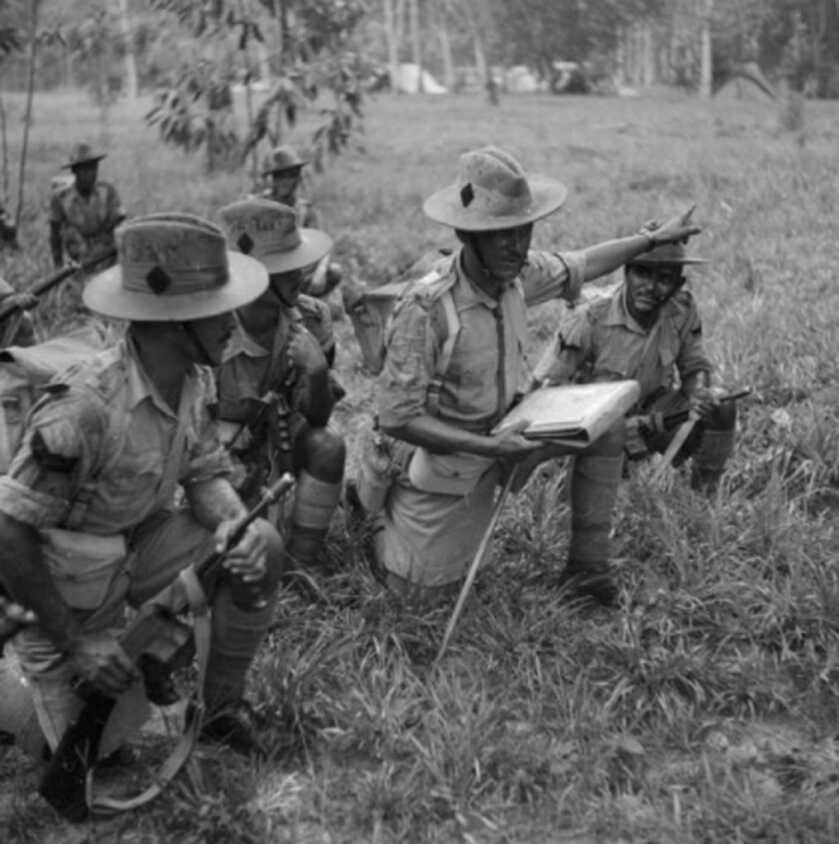
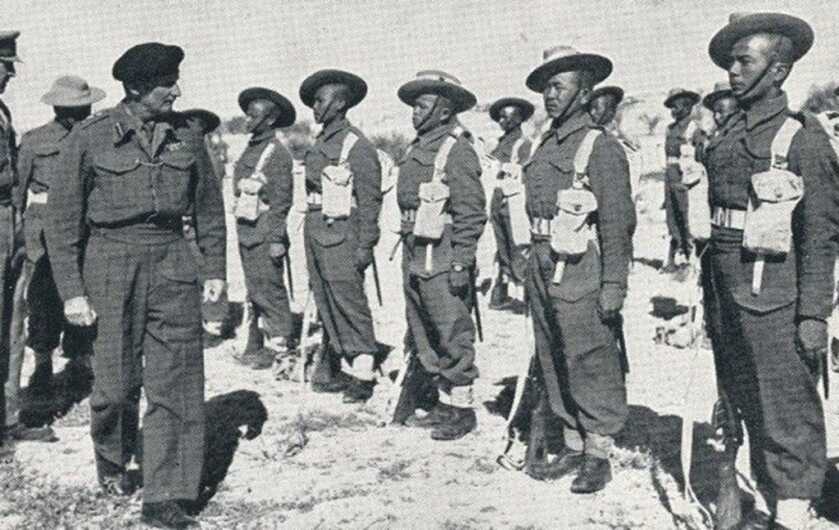 Once the Japanese troops got within hand grenade range they began pelting Gurung’s position with grenades. Gurung picked up the first two and threw them back at his attackers. When he hefted the third it detonated in his hand, removing most of his right hand, blinding his right eye, and peppering his body and face liberally with shrapnel. Where most normal humans would have the good grace to just lay down and die, Gurung unsheathed his Kukri knife, shoved it into the ground at the lip of his foxhole, and announced to the Japanese that they would get no further than that knife. He then hefted his Lee-Enfield rifle, chambered a round with his left hand, and invited the Japanese to see what it was like to, “Come fight a Gurkha.”
Once the Japanese troops got within hand grenade range they began pelting Gurung’s position with grenades. Gurung picked up the first two and threw them back at his attackers. When he hefted the third it detonated in his hand, removing most of his right hand, blinding his right eye, and peppering his body and face liberally with shrapnel. Where most normal humans would have the good grace to just lay down and die, Gurung unsheathed his Kukri knife, shoved it into the ground at the lip of his foxhole, and announced to the Japanese that they would get no further than that knife. He then hefted his Lee-Enfield rifle, chambered a round with his left hand, and invited the Japanese to see what it was like to, “Come fight a Gurkha.”
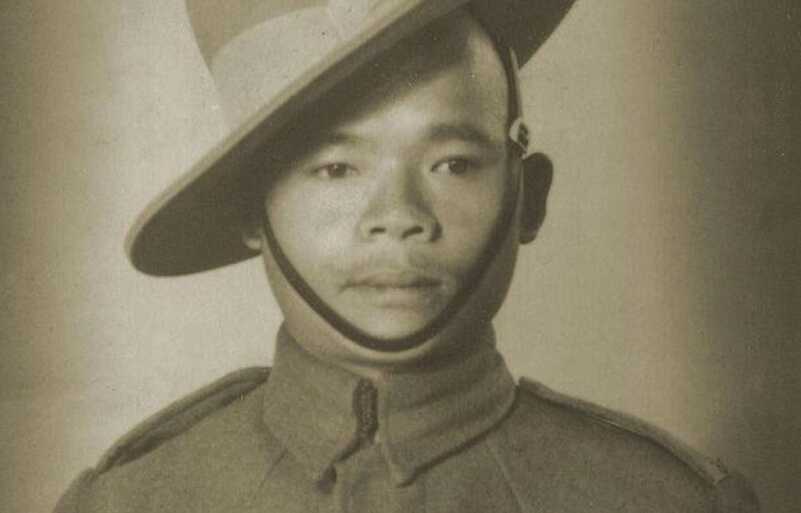
At only 4 feet 11 inches tall, Lachhiman Gurung did not seem like a particularly imposing figure. However, behind a Lee Enfield rifle he wrought sheer havoc upon attacking Japanese forces despite grievous wounds.
The Japanese accepted Gurung’s offer. For the next four hours, Lachhiman Gurung ran his bolt-action Lee-Enfield rifle one-handed, setting the rifle down to work the bolt or reload with his left hand before taking it up again to kill more Japanese. When the Japanese got close enough to overrun his position Gurung would lay down, let them come in close, and then jump up to cut them down at point blank range, all the while running his bolt-action rifle with his single remaining hand.
When he was finally relieved, there were thirty-one dead Japanese soldiers in and around Gurung’s fighting position. He was heard by nearby troops shouting, “Come and fight! Come and fight! I will kill you!” in an effort at taunting the Japanese in closer. Lachhiman Gurung was awarded the Victoria Cross, Britain’s highest award for valor in combat, for his actions that night in the sweltering Burmese jungle. The fanatical defense of that forlorn combat outpost by a single Nepalese Gurkha, himself less than five feet tall, demonstrated to all involved that a single determined man with a rifle can be a formidable combat implement.
The Gun
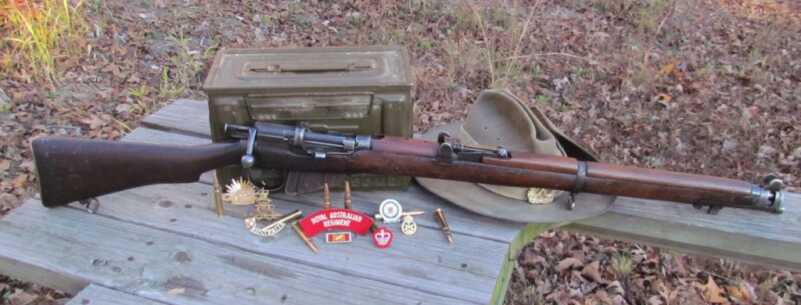
The SMLE No 1 armed British troops throughout World War I and into World War II. Many Commonwealth soldiers used this reliable bolt-action repeater through the end of the conflict.
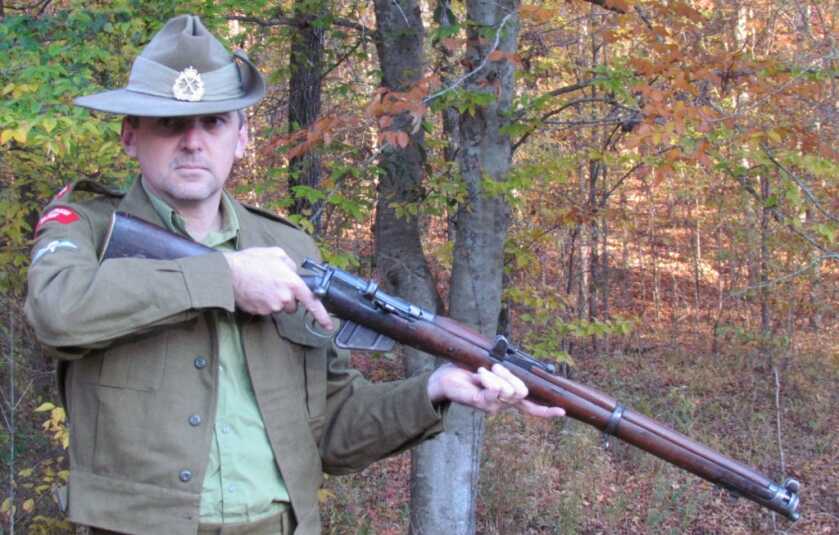 The Lee-Enfield rifle was first adopted in 1895, and it soldiered on through a variety of marks until it was finally supplanted by the L1A1 variant of the FN FAL in 1957. More than 17 million of the guns saw service. Possession of a Lee-Enfield rifle marks one as a warlord of distinction in Afghanistan even today. Designed by a Scotsman named James Paris Lee, the Lee-Enfield superseded the Lee-Metford rifle. Its longevity in service is exceeded solely by the Russian Mosin-Nagant.
The Lee-Enfield rifle was first adopted in 1895, and it soldiered on through a variety of marks until it was finally supplanted by the L1A1 variant of the FN FAL in 1957. More than 17 million of the guns saw service. Possession of a Lee-Enfield rifle marks one as a warlord of distinction in Afghanistan even today. Designed by a Scotsman named James Paris Lee, the Lee-Enfield superseded the Lee-Metford rifle. Its longevity in service is exceeded solely by the Russian Mosin-Nagant.
The Lee-Enfield in its sundry guises fed from a detachable ten-round box magazine. However, in action troops were trained to charge the rifle from the top via either loose rounds or five-round stripper clips. Early SMLE (Short Magazine Lee-Enfield) No 1 versions featured a pivoting magazine cutoff plate that only allowed the weapon to be fired one round at a time. Troops who carried the SMLE referred to it affectionately as the “Smelly.” At the time it was introduced it was thought the magazine cutoff might reduce the British troops’ tendencies toward profligate ammunition expenditure. As mechanical restrictions on one’s onboard ammo supply are typically not terribly popular in combat this superfluous appendage was deleted in short order.
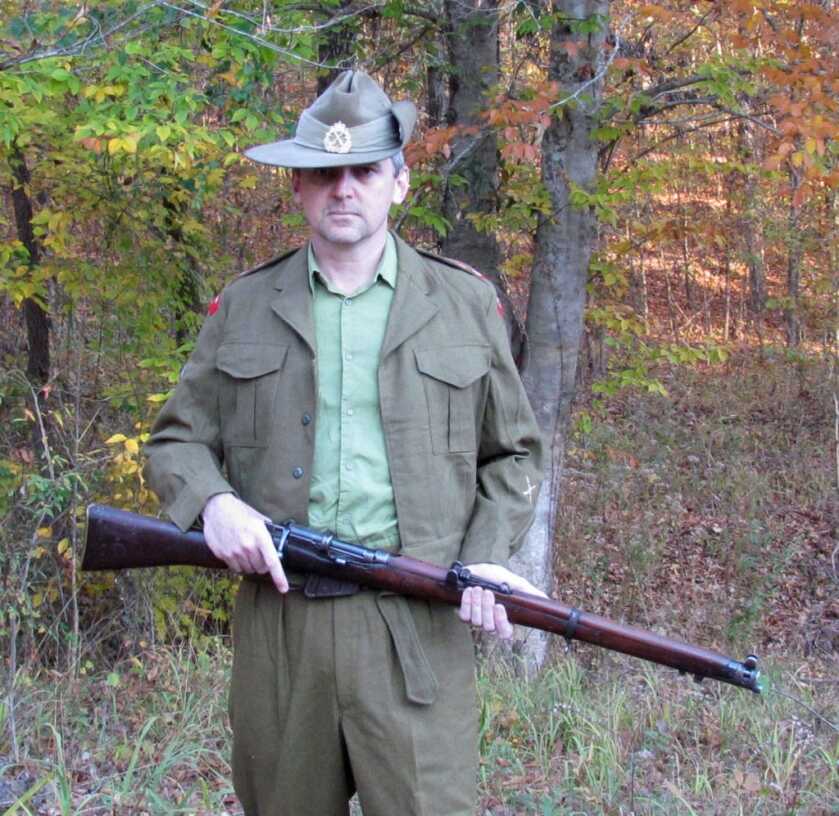 The Lee-Enfield sported rear-locking lugs along with a short bolt throw. In addition, the action cocks on closing while most competing designs cock when you open the bolt. This all conspired to give the Lee-Enfield rifle an exceptionally high rate of fire in the hands of a trained rifleman. British soldiers were trained to fire between twenty and thirty aimed shots per minute as part of a “Mad Minute” exercise. This maneuver was intended to apply maximum fire to an area in as short a period as possible. The current record for performance with a Lee-Enfield rifle is held a British Army rifle instructor named Snoxall who hit a twelve-inch target at 300 meters 38 times in sixty seconds.
The Lee-Enfield sported rear-locking lugs along with a short bolt throw. In addition, the action cocks on closing while most competing designs cock when you open the bolt. This all conspired to give the Lee-Enfield rifle an exceptionally high rate of fire in the hands of a trained rifleman. British soldiers were trained to fire between twenty and thirty aimed shots per minute as part of a “Mad Minute” exercise. This maneuver was intended to apply maximum fire to an area in as short a period as possible. The current record for performance with a Lee-Enfield rifle is held a British Army rifle instructor named Snoxall who hit a twelve-inch target at 300 meters 38 times in sixty seconds.
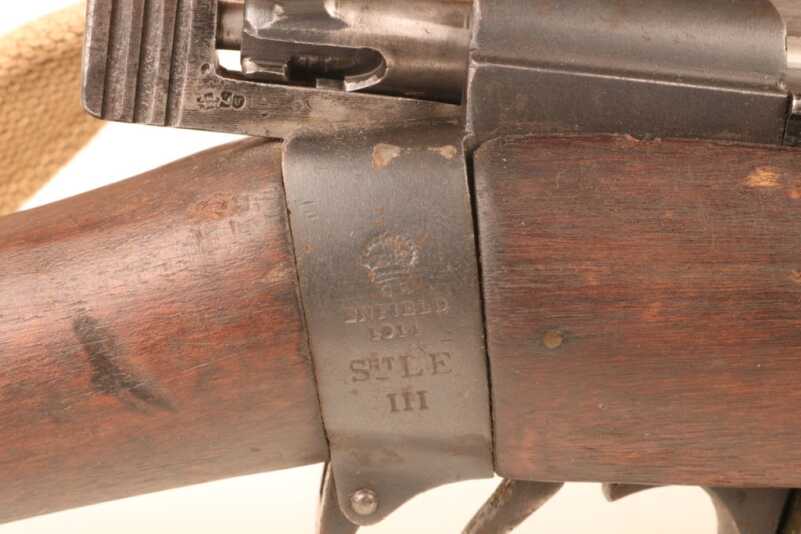
The SMLE’s vital statistics are inscribed on the wrist of the weapon. This particular example was produced in 1914 and bears the inscription “GR” for “George Rex.”
For all its remarkable performance the SMLE No. 1 was an expensive rifle to produce. The SMLE soldiered on in Imperial service throughout World War II, particularly among Commonwealth troops. It was an SMLE No. 1 Mk III that Lachhiman Gurung wielded that night in Burma. However, after Dunkirk the Brits needed something they could produce a little faster. Enter the simplified No. 4 Lee-Enfield. The No 1 and the No. 4 can be easily discerned at a glance by their muzzle bosses. The No. 1 has a stubby nose. The No 4 sports a small bit of barrel protruding out the front. Each rifle accepts a different bayonet.
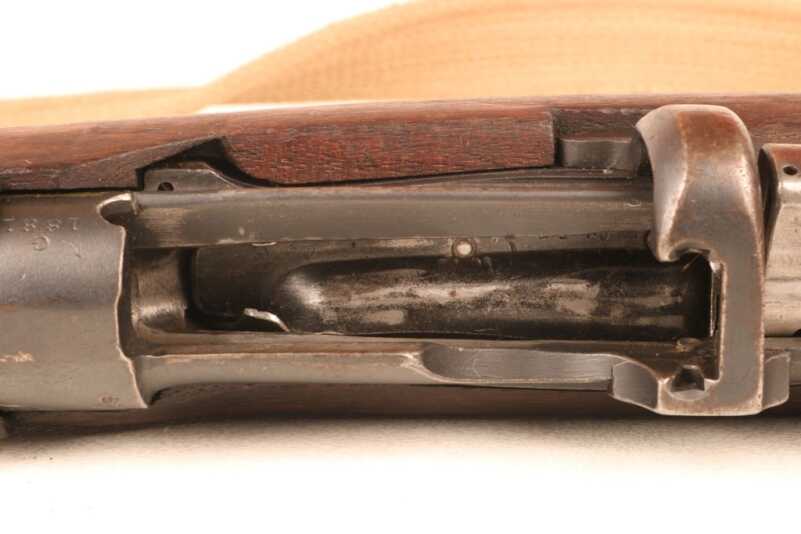
Despite its detachable magazine, the SMLE rifle was intended to be charged from the top via stripper clips. Early models had the magazine attached to the rifle via a short length of chain to prevent its loss.
The No. 4 came in several variations but most featured simplified flip-adjustable rear sights and somewhat cruder construction. Early SMLE No. 1 rifles had sights graduated out to 2,000 meters. Troops of this era were trained to use their rifles for massed volley fire as well as indirect fire over obstacles. There are numerous anecdotes of German troops in WWII believing they were under attack from machineguns when in reality they were simply being subject to the massed fire from trained British riflemen.
The No. 5 Mk 1 became known as the Jungle Carbine. This Lee Enfield rifle sported a shorter barrel, cut-down stock, and lightening cuts to make the rifle as lightweight as possible. All this conspired to enhance the Lee-Enfield’s already prodigious recoil.
The No. 5 Mk 1 (T) was the dedicated sniper version of the No. 4 Lee Enfield. Equipped with a wooden cheekpiece and a 3.5X telescopic sight, this superb sniper rifle served throughout WWII and Korea. The accuracy requirements for these rifles demanded that they place 7 out of 7 shots within a 5-inch circle at 200 yards.
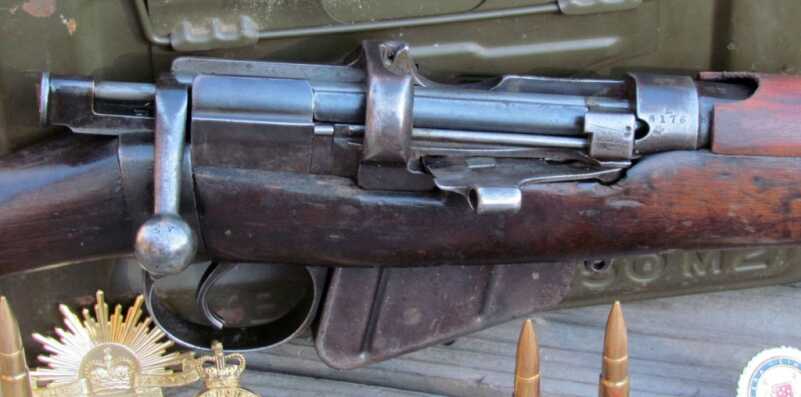
Early SMLE No 1 rifles sported a magazine cutoff feature that mandated that the rifle be loaded one round at a time. This superfluous device was deleted in short order. Early SMLE No 1 rifles sported a magazine cutoff feature that mandated that the rifle be loaded one round at a time. This superfluous device was deleted in short order.
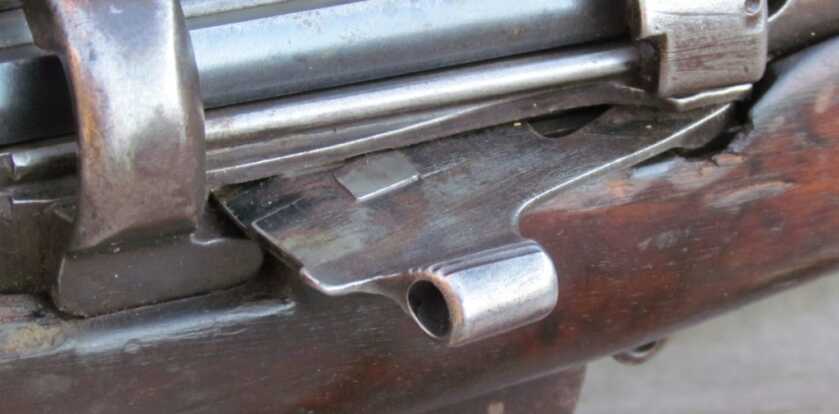 I have a friend who was shot in the chest by a Chinese sniper wielding a captured No. 5 Mk 1 (T) during the Korean War. My buddy was wearing a brand new flak jacket at the time. The round struck the 1911A1 pistol he was carrying in a shoulder holster before deflecting into his flak vest, leaving him bruised but otherwise unhurt.
I have a friend who was shot in the chest by a Chinese sniper wielding a captured No. 5 Mk 1 (T) during the Korean War. My buddy was wearing a brand new flak jacket at the time. The round struck the 1911A1 pistol he was carrying in a shoulder holster before deflecting into his flak vest, leaving him bruised but otherwise unhurt.
The wrist of the Lee Enfield rifle typically holds the gun’s vital statistics. The “GR” marking stands for “George Rex,” the British monarch reigning during the production of most of these early guns. These rifles were produced at a variety of facilities on several continents to include plants in the US and Canada. The Lee-Enfield saw service everywhere the British fought during the first half of the 20th century.

The No. 4 Lee Enfield rifle was the definitive WWII model. It was cheaper and faster to build than the WWI-era No. 1.
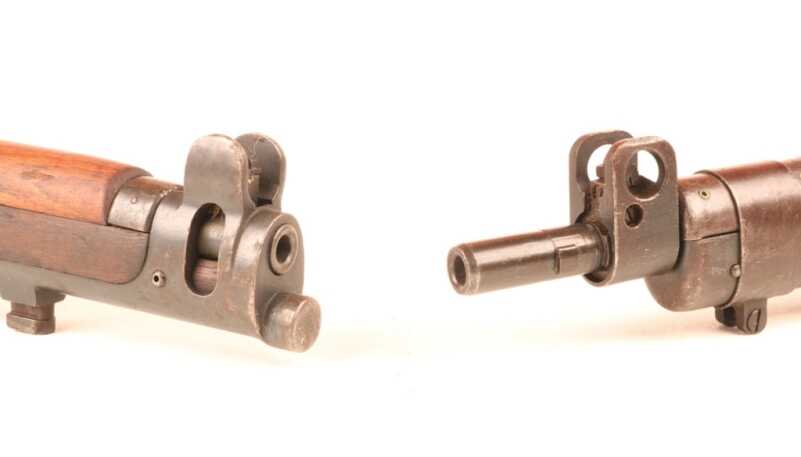
The No. 4 Lee Enfield sports a stubby bit of barrel out the snout. The No. 1 has a flattened nose cap. This is the easiest way to differentiate the two rifles at a glance.

The shortened No. 5 Lee Enfield included a conical flash suppressor and was called the Jungle Carbine.

The German Kar 98k cocks on opening. The Lee Enfield cocks on closing. This makes the British rifle faster in action.
Post Script
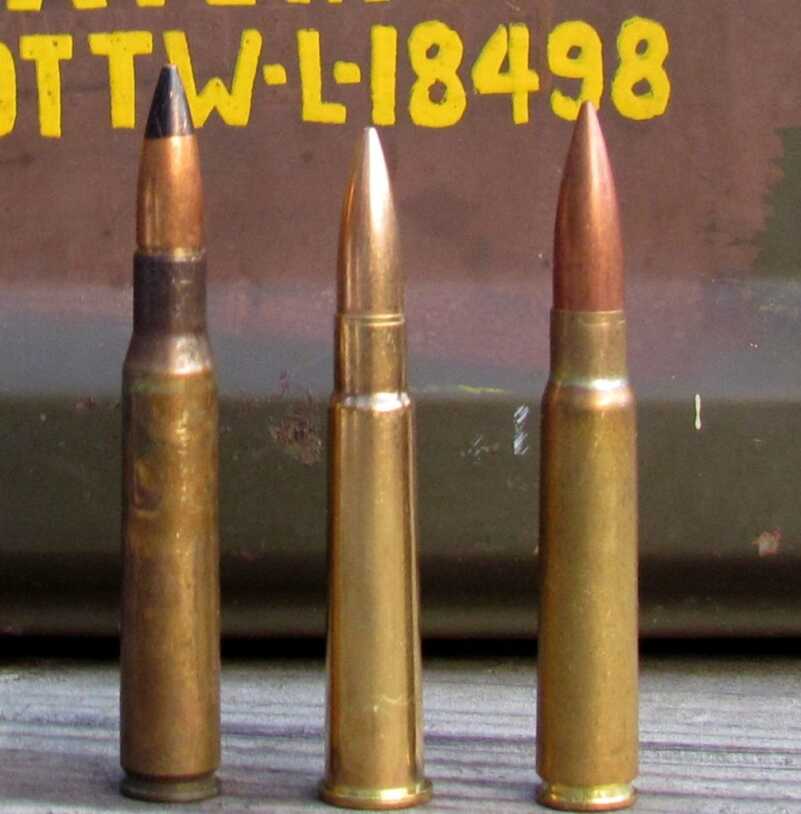
From left to right—the American .30-06, the British .303-in Rimmed, and the German 7.97x57mm Mauser.
Lachhiman Gurung’s primary complaint after the protracted night action that decimated his unit and cost him an eye and an arm was that his injured arm kept attracting flies. He ultimately healed and returned to his native Nepal as a farmer. In time he immigrated to the UK.
In 2008 the UK adopted a policy that revoked the rights of some Gurkha veterans who retired prior to 1997 and lived in the country. The actual term used was that the Gurkhas had “failed to demonstrate strong ties to the UK.” In response, Lachhiman Gurung hefted his ludicrously huge rack of medals and headed for Britain’s’ High Court. In a classic “Don’t Make-Me-Come-Over-There” moment, this rugged little half-blind one-armed man showed the members of the court the face of true dedication and got the onerous law overturned. Lacchiman Gurung died of natural causes in 2010 at age 92.
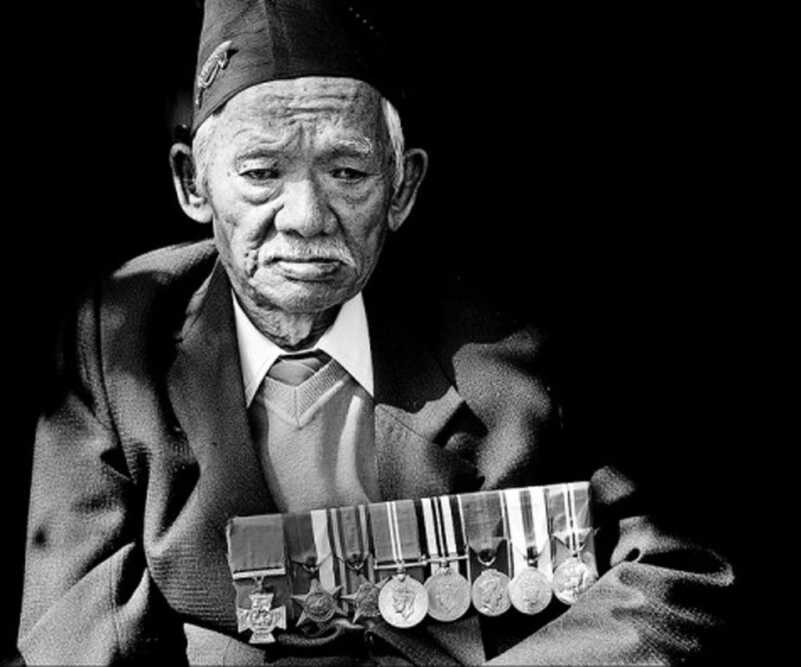
Lacchiman Gurung lived out his days in the UK as a hero. When ill-advised legislation threatening to strip Gurkha veterans of their benefits he rucked up again and made things right. I wouldn’t want this little half-blind one-armed man after me.
The Lee-Enfield rifle was the backbone of the British armed forces for more than half a century. Rugged, powerful, accurate, and fast, this classic bolt-action rifle and the rimmed .303-inch cartridge it fired expressed the will of the English people at the farthest reaches of their influence. In the hands of extraordinary men like Lachhiman Gurung the Lee-Enfield was the long arm of the British Empire.
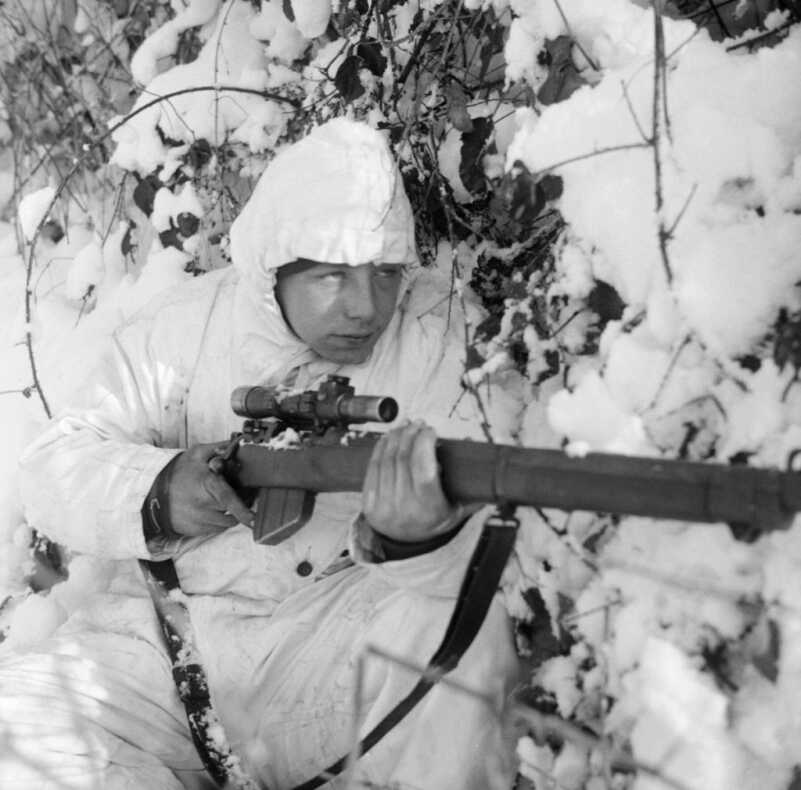
The Lee Enfield No. 5 Mk 1 (T) was the scoped sniper version of the rifle. It saw service throughout WWII and Korea.
Technical Specifications
No. 4 Lee Enfield Rifle
Caliber .303 British Mk VII SAA Ball–Rimmed
Weight 9.06 lbs
Length 44.45 in
Barrel Length 25.2 in
Feed System 10-Round Detachable Box Magazine/5-Round Charger Clips
Sights Fixed and Adjustable Aperture Sights

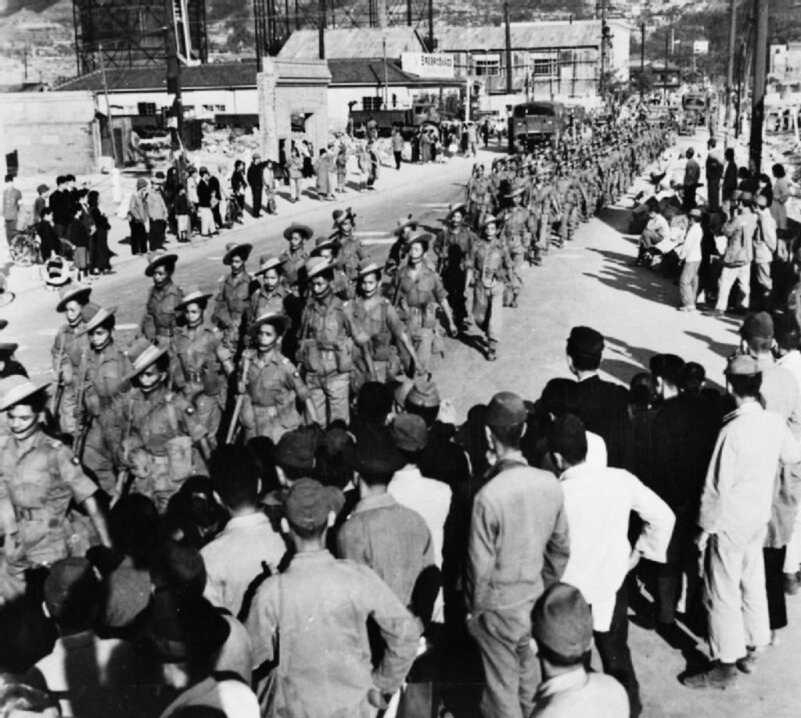
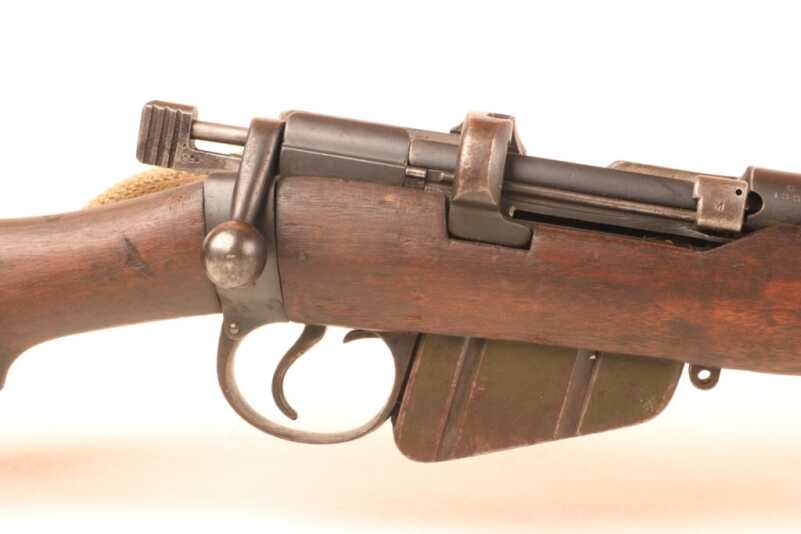
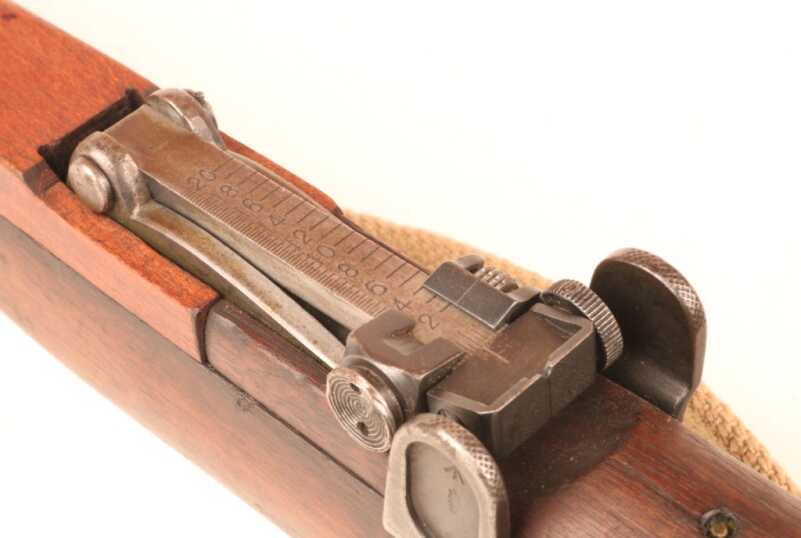
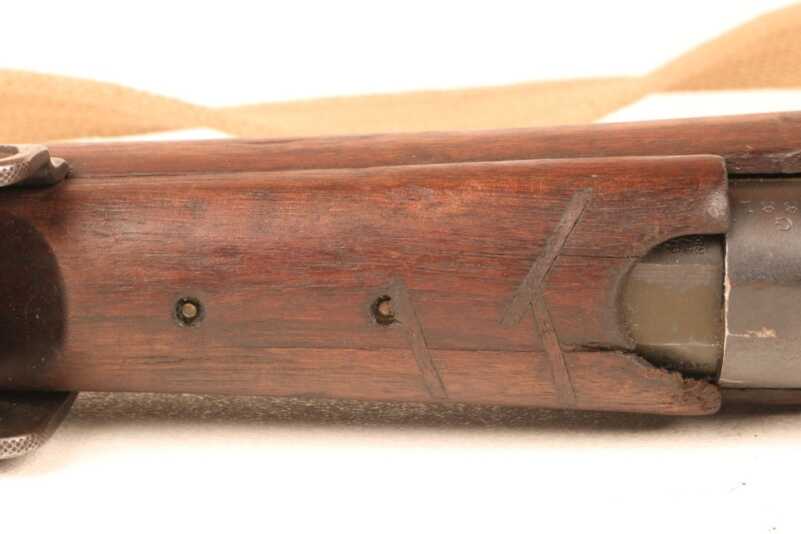
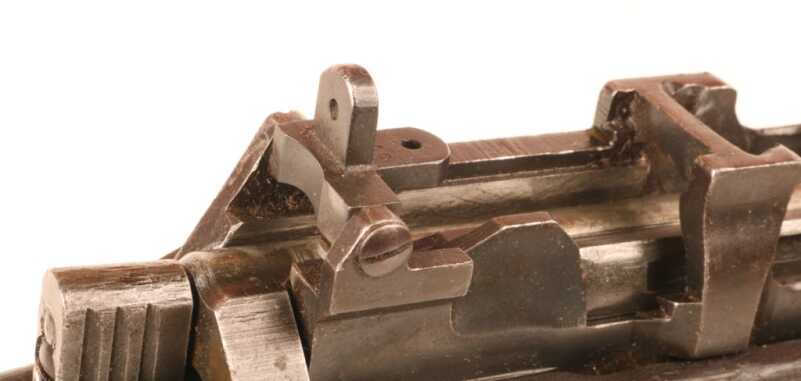
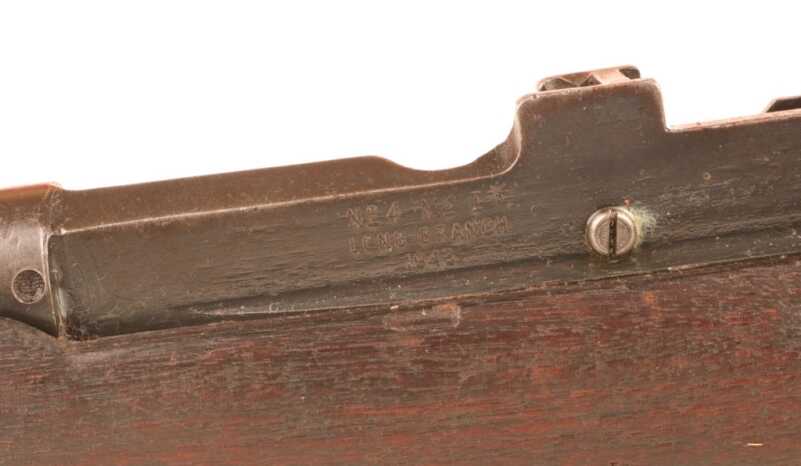
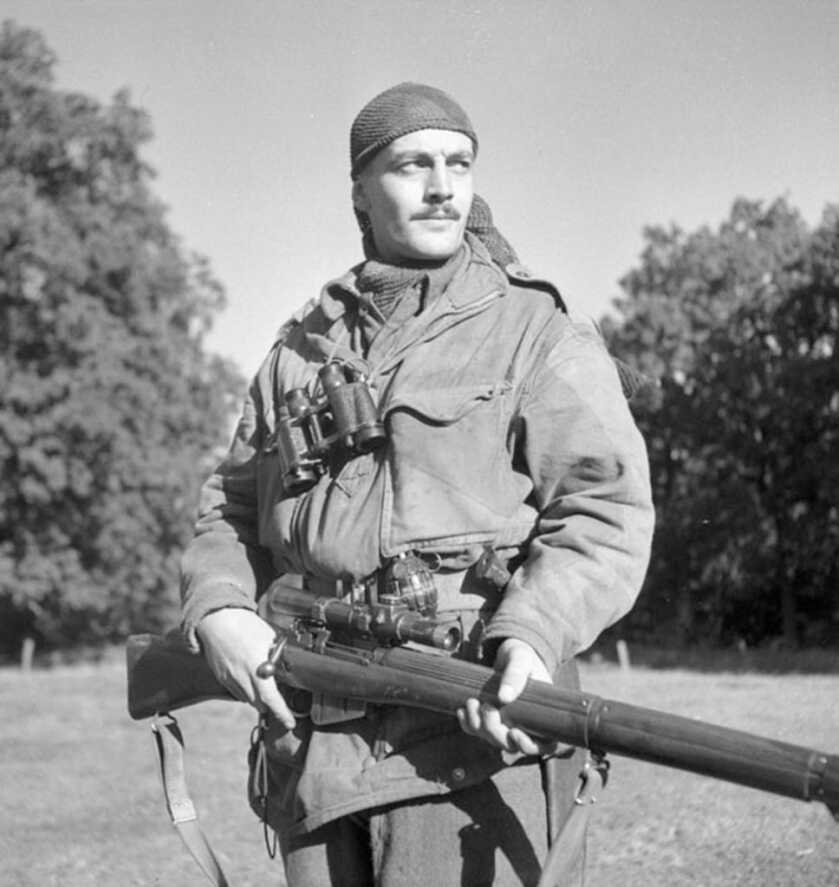

I love my Lee Enfields. I’m blessed with a wonderful selection, including a No3HT sniper in near mint condition. It started with a Smellie. Doesn’t every good collection, then a bayonet then a few more,, and finally a collection of almost every great British Rifle from the Brown Bess onward, and all shooters. Just building my own L42A1 from a nice British No4Mk1*. (Of course here in Australia they won’t let us have the self-loaders and automatic rifles anymore, for shooting anyway.)
Sadly I still lack a Baker, a Brunswick and a Lancaster but I’m working on them. Every one is a shooter, and I have a real dilemma every time I go out the range. What to do, what to do?
And I have a great collection of British and Commonwealth training rifles, including one of my to American rifles, the Mossberg M42MB. (The other is an Eddystone P14, sniper No3Mk1T to us.)
My favourite is probably the Martini Enfield, which is amazing in rapid fire mode. 12 rounds in 50 seconds despite being a single loading Martini. Just takes practice. Everyone else seems to love the Snider Enfield 3-band, with its cannon shell projectiles, lovingly hand made by me.
They are not my rifles however, As with all of these wonderful pieces of history, I am just holding them in trust for future generations. I will be sad to leave them behind.
Ayo Gurkali. It is an amazing story. So are the Ghurkas.
And the rifle itself is legendary. On it’s way to having the longest service history of any rifle in use by the Commonwealth and others (King of Jordan’s Royal Guard still use them). Only beaten by the career of the Brown Bess in Empire use.
None top the Gurkha! If we meet hostile alien races it’ll be the Gurkha that cause their incontinence
The CANUCKS had their greatest (as in best) killers in the 1st Special Service, the Canadian American REGIMENT. Now their SOFs, PPI, and Airborne Regiment is all they really have but they are BAD ASSES. As a former US Army Ranger (scroll as well as tab) I can attest.
Dr Dabbs
I would like to point out 2 minor errors. The sniper version of the Enfield in WW 2 was a No4 Mk 1(T) not a No5 and the magazine cut off on the No1 Mk111 was not removed until 1916. It was then restored when peace time came between the world wars.
The canadian rangers still use enfields!
Looks like i need to add one to the collection.
I am very pleased with my old No. 1. I bought it about 15 years ago at a local gunship in rural NYS. I paid $75.00 for it, and it looked a sorry sight. I went to work and cleaned it up, even polished the heavy brass butt plate. It does not have a speck of rust or pitting, and the only thing I changed was I had a master cabinet maker drill out the disc plug, and I found a genuine brass disc. The bore is bright, all numbers are correct, someone at one time hand stamped the floor plate with the serial number. I even found a genuine bayonet that is correct for it. I think it is worth a little more than $15.00 now.
***
In the early 1960’s a friend and I went to the Seattle World’s fair. We took the ferry to Victoria, BC. one day. While visiting this beautiful city–we went into a sporting goods store. On a big table–more than 100 Lee–Enfield rifles! IIRC around $15 bucks U.S. In good condition. We didn’t buy any because we didn’t think the U.S. Customs would have liked them much when we tried to bring them into the U.S.!
***
John Bibb
***
The author said, “More than 17 million of the guns saw service. … Designed by a Scotsman named James Paris Lee, the Lee-Enfield superseded the Lee-Metford rifle. Its longevity in service is exceeded solely by the Russian Mosin-Nagant.”
That might be true of bolt-action rifles, but the various versions of the Land Pattern Musket, more commonly known as “Brown Bess” were in service for over a century.
I love SMLE rifles and have a No. 4 Mk2. I recommend a book, “The Poor Manvs Sniper Rifle” by D Boone from Desert Publications. He (Boone) highly recommends this rifle as one which can easily be turned into a marksman rifle. I followed the instructions and I’m totally pleased my rifle.
My son stumbled upon an American made Savage , marked U.S. Property , a year
back . The price was’nt too hateful , and as he collects bolt rifles from W.W.II , he
was more than happy to lay the funds out . I will admit , it’s a shooter , in first rate
condition , and was an excellent purchase . If one should happen upon a specimen
in useable condition , I would recommend they purchase it . They won’t be
disappointed.
1. James Parris Lee was a Canadian who immigrated from Scotland; his parents brought him and his siblings with them when they immigrated to Canada to open a watchmaking business. He designed and developed the Lee Enfield rifle in Wallaceburg Ontario, where descendants of the family live there to this day. There is a small museum there dedicated to the Lee and the Lee-Enfield rifle. A short video of the museum can be seen here:
https://www.milsurps.com/showthread.php?t=42898&s=5d5c038cd9005c7274cbcf730b6ddbf8
2. The Lee Enfield is in fact still in service with the Canadian Rangers (although a few months ago the Canadians began replacing it). I am not sure, but I think India and possibly Pakistan still have some territorial units armed with Lee Enfields.
3. There is no such thing as a No. 5 Mk 1 (T) sniper rifle. The sniper variants were the No. 4 Mk 1 (T) and No. 4 Mk 1* (T). They are almost always stamped “T” or “TR” on the left side of the action.
4. The Canadian soldier shown standing is Sgt Harold Marshall, from the Calgary Highlanders’ Scout and Sniper Platoon.
5. And other stuff. A great authoritative website for the Lee Enfield variants is milsurps.com. Time to go to work.
Regarding the magazine cut-off, the justification for ammo conservation was to load and retain 10 rounds in the magazine, and single-load from the banodlier while enemies were at distance – when they came into closer range, the order was given for ‘magazine fire’, and then the cutoff was opened and shots discharged more rapidly. Having ten in reserve in the magazine also meant that if a position was suprised, the soldiers also had ten rounds ready to go immediately.
Early SMLE No.1 Mk.3s (up until 1915, I beleive), also had the simple volley sights mounted on the left hand side – these were graduated out to 2800 yards, and were used to rain lead down into a ‘beaten zone’ when a massed body of enemies were approaching. There are several accounts of enemy advances being decimated/demoralised and turning back before getting anywhere close to the defending unit. (I’ve got volley sights on my 1915, and the angle you have to hold the rifle at for 2800 yards is phenomenal!) (I hasten to add, I didn’t actually try to shoot it at this range!)
I loved the article and have admired this rifle for many years. One particular comment and I hope for clarification from anyone who knows more about it: it seems to me from my years of interest and research, isn’t the target model a No 4 Mk 1(T) and not a No 5 as noted in the writing? I know that I have been pursuing ownership of one of these for many years (good models in shootable condition come at quite a nice price!) and am often teased into thinking of making over a regular No 4 Mk 1 into the target model.
You are correct about the name of the sniper rifle. No. 4 Mk 1 (T) and No. 4 Mk 1* (T)
In Canada where most of the existing sniper variants are located, the rifle complete with box, scope, etc was costing north of $5,000 a few years ago.
Building faux T is becoming popular enough that Luthor Walther did a run of Lee Enfield barrels last year. Replica scope mounts and bases are being made, ditto for modifying the civilian scopes to being sniper variants. My younger brother is currently doing this as a distraction from his Ross Rifle obsession and he’s about three quarters there, using a bubba’d 1942 Long Branch to start with.
Great article.my Jungle Carbine was stolen by one of my patients. I was at 95 emac in Vietnam,44 evac desert storm.never fired a weapon either time.sure enjoyed the article..if Dr Dabbs has a mailer Iwould like to be on his list. What an interesting career he has had.
I must say this venerable old rifle has great history. The stories it could tell. Make no mistake it takes a seasoned soldier to handle it, however. It’s big, heavy, and kicks like the meanest mule of the lot! But what a great shooter!
apologize for double tap.
The Kaiser\’s troops in WW I were the ones who had difficulty understanding they were being chopped to pieces by rifle fire, not British battalions armed solely with machine guns. Youthful German volunteers with little training and no experience were shot down in windrows by long-service British Regulars in the \”Kindermord von Ypern\” in 1914 Belgium. This \”Massacre of the Innocents at Ypres\” was the genesis of the story, according to what I\’ve read.The British Army of the prewar era was trained with heavy emphasis in individual marksmanship, following the debacle of the 1898-1900 Boer War, in which Transvaal and Orange Free State Boers used 7mm Mausers and sharpshooting frontier-style marksmanship to outshoot British units at long range. Brits were largely armed with inferior Lee-Medfords and an early .303 cartridge of lesser ballistic capability (think U.S. .30-40 or .30-03 vs. .30-06, or German .318 vs. .323, round nose versus spitzer). Further, they were trained to emphasize the volley fire typical of the black powder era, followed by a disciplined bayonet assault to overrun an enemy position. They found it difficult to close to bayonet range against Boer mounted infantry on their native veld in southern Africa.By 1914, however, the worm had turned. British infantrymen were armed with the SMLE, improved .303 ammunition, some 10-15 years of heavy emphasis on individual marksmanship, and regulations required proficiency in firing \”15 rounds rapid!\” upon command. Running through 10 aimed shots from a full magazine, they independently loaded one additional charger of 5 rounds and continued firing. I\’m certain their standard was to fire these 15 aimed shots in one minute or less, but it\’s quite possible that regulations required an even shorter time limit. Certainly, as mentioned in this article, many British soldiers handily exceeded 15 rpm of well-aimed fire.At close ranges, men learned to pull the trigger with their middle finger, keeping thumb and forefinger on the knobby end of the bolt handle. A flick of the wrist cycled the bolt, allowing them to fire the next shot with minimal delay and physical disturbance. The results were devastating to massed German infantry formations at ranges of 600+ yards, and .303 bullets commonly took out more than one German.The British Expeditionary Force (BEF) of 1914 delivered rifle fire with a speed, accuracy, and effective range that totally outclassed any other armed force in the world. They had the right rifle, ammunition, training, experience, and discipline. The results were astonishingly lethal.
The Kaiser’s troops in WW I were the ones who had difficulty understanding they were being chopped to pieces by rifle fire, not British battalions armed solely with machine guns. Youthful German volunteers with little training and no experience were shot down in windrows by long-service British Regulars in the “Kindermord von Ypern” in 1914 Belgium. This “Massacre of the Innocents at Ypres” was the genesis of the story, according to what I’ve read.
The British Army of the prewar era was trained with heavy emphasis in individual marksmanship, following the debacle of the 1898-1900 Boer War, in which Transvaal and Orange Free State Boers used 7mm Mausers and sharpshooting frontier-style marksmanship to outshoot British units at long range. Brits were largely armed with inferior Lee-Medfords and an early .303 cartridge of lesser ballistic capability (think U.S. .30-40 or .30-03 vs. .30-06, or German .318 vs. .323, round nose versus spitzer). Further, they were trained to emphasize the volley fire typical of the black powder era, followed by a disciplined bayonet assault to overrun an enemy position. They found it difficult to close to bayonet range against Boer mounted infantry on their native veld in southern Africa.
By 1914, however, the worm had turned. British infantrymen were armed with the SMLE, improved .303 ammunition, some 10-15 years of heavy emphasis on individual marksmanship, and regulations required proficiency in firing “15 rounds rapid!” upon command. Running through 10 aimed shots from a full magazine, they independently loaded one additional charger of 5 rounds and continued firing. I’m certain their standard was to fire these 15 aimed shots in one minute or less, but it’s quite possible that regulations required an even shorter time limit. Certainly, as mentioned in this article, many British soldiers handily exceeded 15 rpm of well-aimed fire.
At close ranges, men learned to pull the trigger with their middle finger, keeping thumb and forefinger on the knobby end of the bolt handle. A flick of the wrist cycled the bolt, allowing them to fire the next shot with minimal delay and physical disturbance. The results were devastating to massed German infantry formations at ranges of 600+ yards, and .303 bullets commonly took out more than one German.
The British Expeditionary Force (BEF) of 1914 delivered rifle fire with a speed, accuracy, and effective range that totally outclassed any other armed force in the world. They had the right rifle, ammunition, training, experience, and discipline. The results were astonishingly lethal.
Great article on a great rifle. I own several firearms, and my SMLE is the favorite.